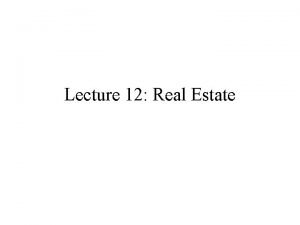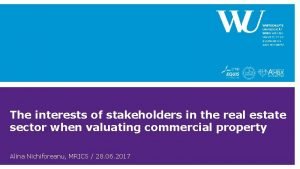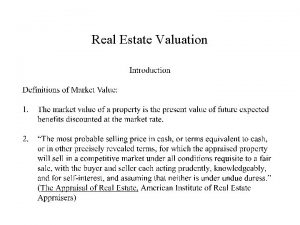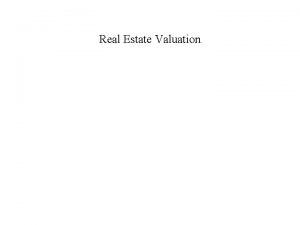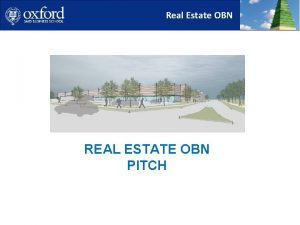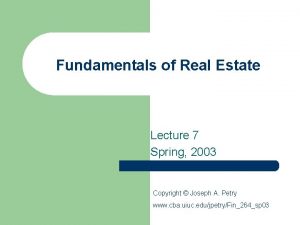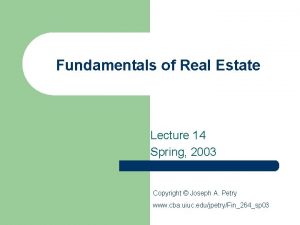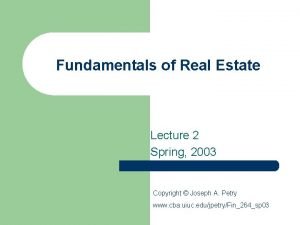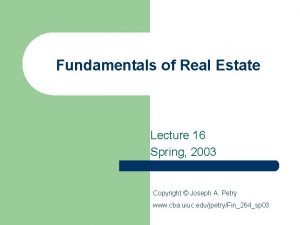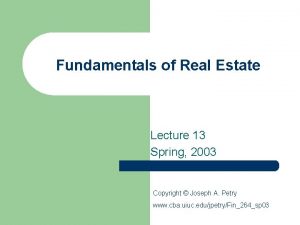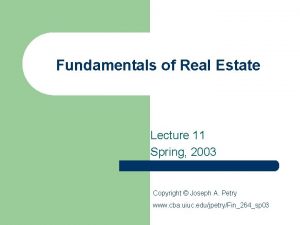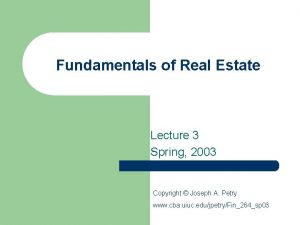Fundamentals of Real Estate Lecture 8 Spring 2003












- Slides: 12

Fundamentals of Real Estate Lecture 8 Spring, 2003 Copyright © Joseph A. Petry www. cba. uiuc. edu/jpetry/Fin_264_sp 03

Housekeeping Issues 2 Exam Wednesday, 2/19 l MC, 30 -40 questions, similar to homework, class examples. Exam will cover ch. 1 -4. l You should read each chapter carefully as well as know lecture and homework material. Today, we are going to put all of the financial analysis we have learned to work. Divide into your groups and work out the answers to example #2.

3

Taxation at Sale of Property 4

Taxation at Sale of Property 5

Taxation at Sale of Property 6

Taxation at Sale of Property 7

Taxation at Sale of Property 8

Federal Income Taxation 9

10

Taxation at Sale of Property 11 Example #1 (from last time): Assume the following regarding a nonresidential building: The purchase price is 450, 000. The investor obtains a 360, 000 loan. There are no financing costs. The investor expects the market value of the property to increase to $472, 500 over the anticipated two-year holding period. Selling costs are expected to be 6% of the estimated sales price. The investor is in the 28% ordinary tax bracket. Capital gains will be taxed at 20%. Assume that the balance of the loan at the time of sale will be $354, 276. Also assume that 15% of the purchase price represents the value of the land, and that improvements (the building) are depreciated over 31. 5 years using straight line depreciation. A) compute the annual depreciation deduction, B) compute the adjusted basis at the time of the sale (after two years); C) Compute the tax liability from sale; D) Compute the after-tax cash flow (equity reversion) from sale.

Taxation at Sale of Property Example #2: Assume the following regarding a residential building: The purchase price is 800, 000. The investor obtains a 80% LTV loan, at 7. 5% over 20 years, amortized monthly. There are no financing costs. There are 14 apartments, which rent at 850 per month. You expect it to take 3 months to fill a vacant apartment, and you assume that you will have 3 apartments change hands each year. You expect the market value of the property to increase 4% a year over the anticipated two-year holding period. Selling costs are expected to be 1. 5% of the estimated sales price. Capital gains will be taxed at 20%. Depreciation Recapture is taxed at 25%. Also assume that 12% of the purchase price represents the value of the land. Construct proforma operating statements and tax tables to analyze this investment during its lifetime and upon disposition. 12
 Giduk
Giduk Fundamentals of analyzing real estate investments
Fundamentals of analyzing real estate investments Real estate finance fundamentals
Real estate finance fundamentals Real estate lecture
Real estate lecture South pointe village apartments fishers in
South pointe village apartments fishers in 01:640:244 lecture notes - lecture 15: plat, idah, farad
01:640:244 lecture notes - lecture 15: plat, idah, farad Spring autumn
Spring autumn Realtor elevator pitch examples
Realtor elevator pitch examples What is a mofir
What is a mofir Real estate stakeholders
Real estate stakeholders Greek real estate market
Greek real estate market Sandy miller real estate
Sandy miller real estate Define littoral rights
Define littoral rights



